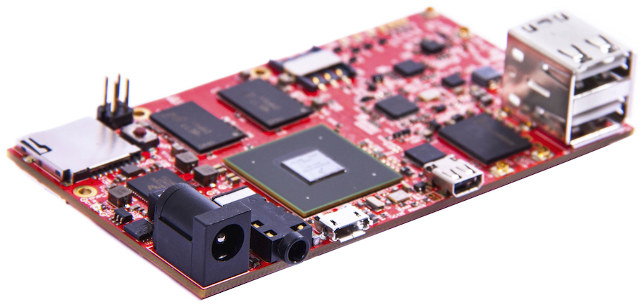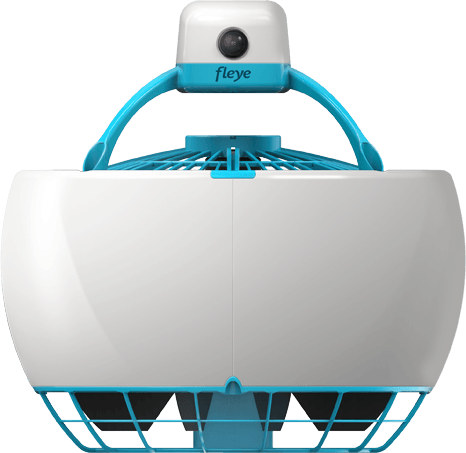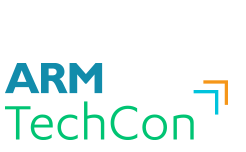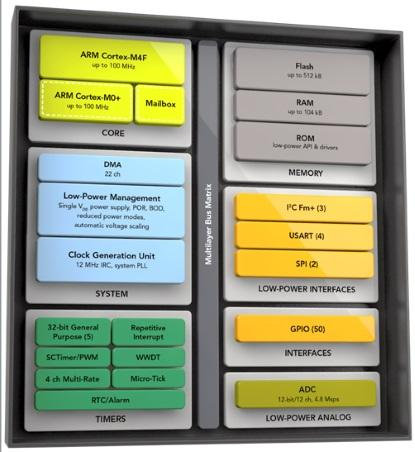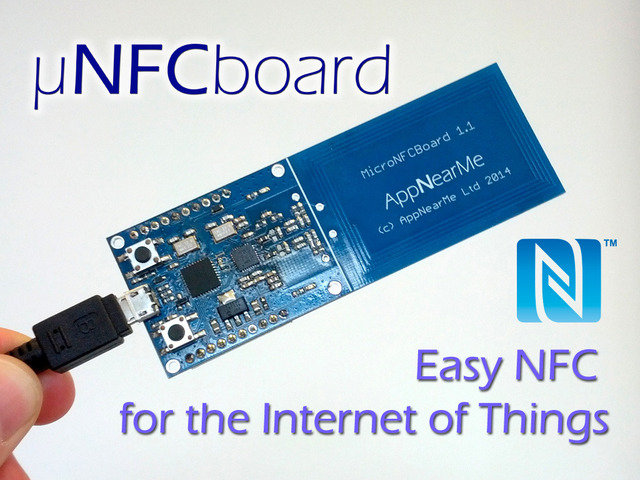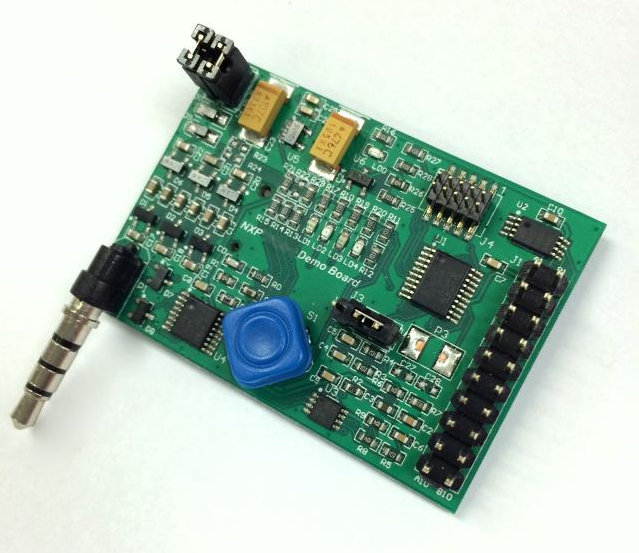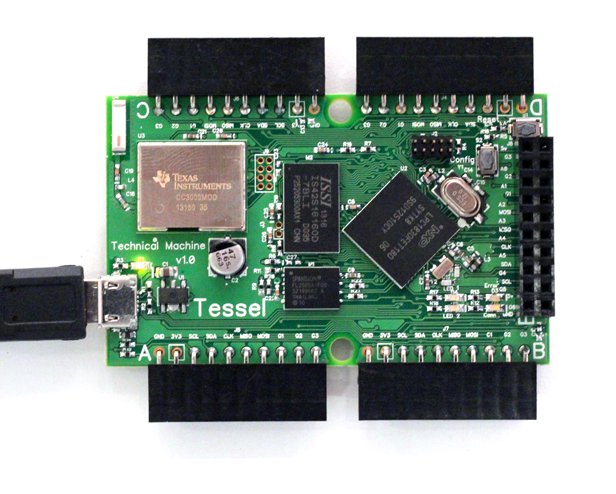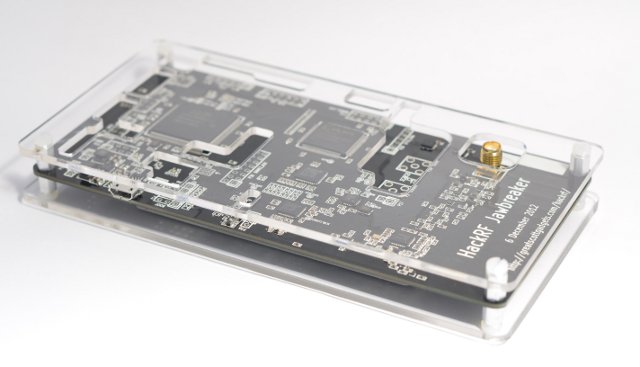Saying that the market now provides a wide range of development boards is probably an understatement, but Code Ing has found out that most hobbyist boards had limited on-board wireless connectivity with WiFi and Bluetooth basically the best you could expect, with any extra wireless functionality requiring USB dongles. So the company designed PixiePro single board computer powered by NXP i.MX6Q quad core Cortex A9 processor with on-board wireless connectivity including WiFi 802.11ac, Bluetooth 4.2, GPS/GLONASS, NFC and a 3G module. PixiePro board specifications: SoC – NXP i.MX6Q quad core Cortex A9 processor @ 1 GHz with Vivante 2D and 3D GPUs System Memory – 2GB 64-bit DDR3 Storage – 2x UHS-I micro SD card slot up to 104 MB/s Video Output – micro HDMI up to 1080p60 Audio Output – HDMI and 3.5mm mini TOSLINK optical port/Line Out Connectivity WiFi 802.11 a/b/g/n/ac 2×2 MIMO with two antenna connectors Bluetooth […]
Fleye is a Safe, Robust and Developer Friendly Drone Powered by NXP i.MX6 Processor (Crowdfunding)
In most cases, it’s a pretty bad idea to touch a drone while it’s flying, as you could potentially hurt yourself and others with the blades, so a startup based in Belgium has decided to design a safe drone with the blades hidden under a shell surrounded by protective grids, and with features such as obstacles avoidance. The design also makes the drone sturdier, and less prone to breakage should it fall or hit obstacles. The drone, dubbed Fleye, is based on NXP i.MX6 dual core processor, runs a Linux OS built with the Yocto Project, and the company also plans to provide APIs, and mobile SDKs to allow the developer community to experiment with the drone, and/or create mobile apps. Main hardware features of Fleye drone: SoC – Freescale NXP i.MX6 dual or quad core ARM Cortex A9 processor @ 800 MHz with Vivante GPU System Memory – 512 […]
ARM TechCon 2015 Schedule – IoT, Servers, 64-bit ARM, Power Usage Optimization, and More
The ARM Technology Conference (ARM TechCon) will take place on November 10 – 12, 2015, in Santa Clara Convention Center, and just like every year, there will be a free exposition for companies to showcase their latest innovation and/or products, as well as a technical conference with sessions and workshops sorted into various tracks: Automotive/Embedded Vision Embedded IoT Mobile/Connectivity Networking Infrastructure/Servers Tools & Implementation Wearables/Sensors ARM Training Day Sponsored Vendor Training Special Event General Event Software Developers Workshop You can find the complete schedule on ARM TechCon website. Although I won’t attend, I’ve created my own virtual schedule with some of the sessions I found interesting. Tuesday – November 10 8:30 – 9:20 – ARM Vision for Thermal Management and Energy Aware Scheduling on Linux by Ian Rickards (ARM), Charles Garcia-Tobin (ARM), Bobby Batacharia (ARM) This talk will cover the history and where are we going, for ARM’s Power Software (IPA, […]
NXP Introduces LPC54100 Single & Dual Core Cortex M4F/M0+ MCU Family and LPCXpresso54102 Development Kit
NXP has recently introduced LPC54100 Series microcontrollers with a Cortex-M4F core up to 100MHz, and optionally an ARM Cortex M0+ core for always-on sensor processing applications, as well as LPCXpresso 54102 board. Typical applications include mobile, portable health and fitness, home and building automation, fleet management and asset tracking, robotics and gaming. Key features of LPC54100 series MCUs: CPU – 32-bit ARM Cortex-M4F up to 100 MHz, optional 32-bit ARM Cortex-M0+ coprocessor On-chip RAM – 104 KB internal RAM On-chip Storage – Up to 512 KB on-chip Flash Interfaces 3 fast-mode plus I²C, 4 UART, 2 SPI, 39 GPIO ADC with up to 12-channels, 12 bits, and 4.8 Msps sample rate, full-spec (1.62 V to 3.6 V) Clock Sources – IRC, digital clock input, PLL, 32 kHz XTAL, WWDT Timers – 5x 32-bit general-purpose timers/counters, One-state configurable timer/PWM, RTC with alarm, and WWDT 22-channel DMA with 20-programmable triggers Power consumption […]
$70 MicroNFCBoard Brings NFC Connectivity to Any Board or Device (Crowdfunding)
AppNearMe MicroNFCBoard is a development platform for Near Field Communication (NFC) comprised of an NFC transceiver, an NXP MCU, and all software stack and tools you need for development. This board also exposes various I/Os that allows you to connect to external hardware or devices, and it can be used with an Arduino, Raspberry Pi, mbed or PC/Mac. Let’s go through the board specifications first: MCU – NXP LPC11U34FHN33/421 Cortex M0 MCU @ 48MHz, with 10KB RAM, 48KB FLASH, 4KB EEPROM NFC Transceiver – NXP PN512. Reader/Writer and card operation modes supporting ISO14443A/Mifare and FeliCa schemes. NFCIP-1 mode Splittable antenna USB – 1x micro USB port for power and programming I/O – 20x through holes with access to serial (UART), I2C, SPI, 4x ADC inputs, IRQ, Boot and Reset, and power pins. (2x pin header that you can solder are provided) Misc – Reset and bootloader enable push-buttons, 2x LEDs. […]
NXP Smartphone Quick-Jack Solution Connects to Your Smartphone Audio Jack and Interfaces with Sensors, HMI Devices
We already knew the audio jack on your mobile device was not only for your headset, thanks to small items like Pressy hardware button. But it’s actually possible to do much more, as shown by NXP smartphone quick-jack solution, a board that can interface sensors to your Android smartphone / tablet or iPhone / iPad via the headphone/microphone jack of your device. The company claims it can be used for various applications such as cloud-based tracking of sensor data, external input devices to smartphone, wearable health monitors, personal exercise trackers, handheld weather stations, handheld inventory monitors, handheld/portable POS devices, and universal remote controls, using powered harvested from the audio jack, and optionally a battery. Let’s go through the hardware specifications of this little board codenamed OM13069: MCU – NXP LPC812 ARM Cortex M0+ MCU @ 30 MHz with 16KB flash, 4KB SRAM On-board peripherals – Joystick, temperature sensor, and LEDs […]
Tessel ARM Cortex-M3 MCU Board Brings Hardware Hacking to Web Developers with JavaScript and Node.js
People who are proficient with JavaScript or web technologies may not be completely comfortable with programming MCU in assembler and/or C programming language. Node.js, written in JavaScript, seems to be quite popular this days for diverse projects, but technical.io has decided to design a board called Tessel, powered by a Cortex M3 MCU. that can be fully programmed with JavaScript/Node.js. Tessel hardware specifications: MCU – NXP LPC1830 ARM Cortex-M3 @ 180mhz System Memory – 32MB SDRAM Storage – 32MB Flash Connectivity – Wi-Fi via TI CC3000 Expansion – 16-pin GPIO bank for prototyping Power – Micro USB or battery The board is said to be compatible with 1000’s of Node.js modules from NPM, can be programmed via USB or Wi-Fi using your own IDE, and support Tessel modules, as well as Arduino Shields. There are two (price) classes for Tessel modules: Class A: Relay — turn devices on and off (up […]
$275 HackRF Open Source Software Defined Radio (SDR) Platform
HackRF is an open source hardware project to build a Software Defined Radio (SDR) supporting a frequency range between 30 MHz and 6GHz in both directions (Tx and Rx, half-duplex) with a maximum bandwidth of 20MHz. Jawbreaker (shown below) is a beta hardware that has been tested by several developers and beta testers, and applications such as Digital Audio Broadcasting (DAB), Bluetooth monitoring, spectrum sensing, wireless microphones, AIS, FM radio, etc.. have already been ported to the platform. In order to lower the cost of the hardware, Michael Ossmann has launched a Kickstarter campaign to fund mass production. There seems to be many SDR enthusiasts as the campaign has already reached its funding target ($80,000) and received for over $300,000 in ledges. What is Software Defined Radio (SDR) and What Can it Be Used for? Before providing details about the hardware and software, it may be useful to provide some […]


